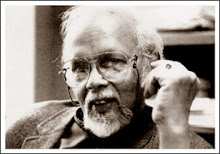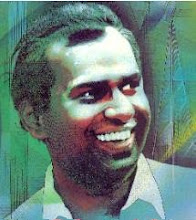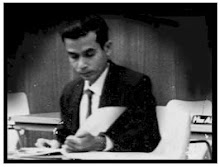 Author: Fazli Sameer
Author: Fazli SameerSource: Lankan Personalities
Date: 15/12/2008
A well known figure in the corridors of Pera and in the music, drama and literary fields, Professor Ashley Halpe now 75, talks of what has shaped his life to Kumudini Hettiarachchi.
Be it sitting on a panel with eminent literary scholars, teaching Shakespeare to fresh-faced 16-year-olds or singing his heart out on stage or at mass – one thing marks him out as “different”.The endearing quality that many great academics lack is ingrained in this professor who needs no introduction.
Humility is Professor Ashley Halpe’s hallmark and sitting before him in his daughter’s home in Mount Lavinia, while his “beloved wife who has unfailingly fed my spirit” Bridget is teaching piano to a boy, The Sunday Times attempts to gain an insight into what has made him what he is.
Prof. Halpe whose name and life have inextricably been linked to literature and the University of Peradeniya for long years, has just reached three-score years plus 15. He celebrated his 75th birthday on November 19.
To find an answer to what makes him tick, Prof. Halpe journeys back to his childhood…..and picks on the great influence his father had on him. “He had a crucial impact. He put books in our hands. Being an excellent artist, he guided me but never thrust literature or art down my throat,” he says. His father, known fondly as Captain Vernon, as he was a Cadet Officer had been the Principal of Lumbini Vidyalaya when the theatre was created there, subsequently becoming the home of Sinhala drama.
Books, books and more books…….a constant flow, enriched by the travels across the country, from Talaimannar to Matara or to the east or the hills. For his father had railway warrants.
In his childhood, Prof. Halpe had never been a Colombo boy, except for a short stint, the final years of the H.Sc. which he spent at St. Peter’s College, Bambalapitiya. Starting his school career at the Montessori at St. John’s College, Panadura, followed by a few years at Holy Cross College, Kalutara, he believes that it was later at De Mazenod College, Kandana, and St. Peter’s College that he was offered more than education. “The primarily Catholic environment was tangible, real,” he says, successfully and naturally nurtured by committed teachers including the Brothers of that order. De Mazenod also had a tradition of choral singing.
Talking about the years when he was studying to get admission to university, he says there was no competition. “If you passed you were in university. The stimulus was the work itself and you competed with yourself.”
St. Peter’s also had a strong tradition of music and drama and that was where the young Halpe was drawn into acting. It was also there that he faced the academic challenge of an open prize system, where whatever the student was studying, science or arts, he could compete for prizes in the other stream. “I tried for every conceivable prize…….this gamaya, while all the other boys were mainly from Colombo 4 itself, and collared three from the other stream (he was doing science) apart from the class prize.”
But never a bookworm, he was also heavily involved in music, choral activity, debating and sports such as cricket, football and tennis, though he was “never very good at cricket”.
Poetry and sketching had always been a passion………a “fantastic holiday” spent at Minipe coming to mind where his uncle who was working there had taken him to see anicuts, birds et al. They would explore the land and this impressionable youth would write poetry “in my head”, come back and reproduce it in exercise books. He also did a lot of sketching.
Suddenly Prof. Halpe remembers the three libraries – De Mazenod, St. Peter’s and also the British Council in Colombo -- which played a major role in his life. The reading was “not streamed and I read what I felt like reading”, science books as well as Eliot, Dickens, Walter Scott, Chaucer, just to see what they were like.
The next “big change” in his life came along with a “shock” to his father who wanted him to become a doctor or scientist when he changed track and decided that it was the arts for him. Facing a gruelling interview he got into university to do arts.
Into the full life of the campus of the University of Ceylon, in the beautiful setting of Peradeniya his “encounter with English”, started early in life, became strengthened. It also opened up new and exciting vistas. Though cut off from Colombo, the hub for concerts and exhibitions, those at Pera, as they call it, never felt “deprived”.
“We did our own thing through Dramsoc (Drama Society) with E.F.C. Ludowyke introducing us to famous directors of the time like Jubal. Around that time, the students also formed themselves into the University Singers, which later became the Peradeniya Singers, under a lecturer in English, Robin Mayhead,” he says. Twice a week for half-an-hour Mayhead put them through their paces in four-part harmony in a cappella style.
The grandeur of nature was just a short walk away. “We savoured the hills about two or three times a month.”
“But it was not only academic and cultural,” adds Prof. Halpe. “Pera was also a world of people. Relationships meant a lot and life-long friendships were forged here.” It was as a young lecturer at Peradeniya that he met his life’s partner, Bridget, whom he says he “grabbed” in 1957 when she joined as a fresher. They married in 1959 and have been inseparable since then, even now travelling down to Colombo by Intercity together to teach students, he English and she music and singing. Family life with their three children was also very important amidst all the work.
For Prof. Halpe, Peradeniya provided every kind of experience, witnessing first-hand the inevitable politicization of the university, the tussles, the group rivalries and also being part and parcel of the tense times…1968 stands out when there was a standoff between the undergraduates and the army. He was Proctor (dealing with discipline) during the challenging years of 1971 (when the country agonized over the first youth insurrection) and would be out of home which was on campus itself for long hours. “There were calls in the middle of the night, there were visits to Bogambara Prison and also Pallekelle and Weerawila camps on behalf of the students.”
Down the years, before the country experienced Black July ’83, some people “jumped the gun” and attacked Tamil students, he recalls, and the students just disappeared, fearful of staying at Peradeniya. It was Prof. Halpe and Dr. Premasiri who were instrumental in getting them back. “We persuaded the lecturers to gently refuse to teach until all students, including the Tamil students, were back in class.”
July ’83 found about 10,000 people fleeing from the violence beingprovided shelter at the Hilda Obeysekera Hall. 1988 -89, the beeshanaya period was “a naked kind of conflict with young people at risk,” says Prof. Halpe.
Retiring from university in 1998, the bonds have not been severed, for he has been invited to continue teaching as a Visiting Lecturer. “Teaching is part of my life,” says Prof. Halpe, while he also continues to direct plays and paint. Not only does he teach at university but does so privately to students sitting the Advanced Level and external degree both local and London. This is what sustains them along with Bridget’s music and singing lessons as they “plunged all my retirement benefits into a house we built at Anniewatte”.
To the public Prof. Halpe and painting are not common knowledge. Drawing has always fascinated him and once again it was his father who took him to the Royal Primary School Principal H.D. Sugathapala who in turn introduced him to Harry Pieris of the famous 43 Group. Prof. Halpe was 18 at that time. Soon after he met Neville Weeraratne. An uncle of his also took him to see Donald Ramanayake and he was the first artist who gave him some tips on choice of colour to suit Lankan landscapes he was dabbling in at that time.
A long and illustrious life. As Prof. Halpe faces a new year, what hopes and plans for the future?To publish as a whole his works that have remained in journals and notebooks, he says, adding that though at the moment it is a fallow period for him as an artist “a canvas on an easel in my room” awaits.



































No comments:
Post a Comment